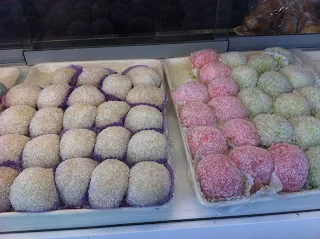I reckon the Cantonese egg tart (pictured above), or the tarn tart, available at most yum cha sessions and in southern Chinese styled bakeries, is an excellent example of cuisine fusion, at its best, or viewed at the other end of the spectrum, an illustration of copying the Portuguese tart sans the caramel sauce. Or is it actually the other way? Granted that the texture and flavour of the custard can be different between the South Atlantic and South China Sea versions, the pivotal evidence is in Macau's past, where Portuguese adventurers of old came aboard and colonised the place, married the native girls and the rest is history - Eurasians bearing Portuguese names but looking like the average Guangdong person perhaps.
I was at the St Honore Cake Shop along Sussex Street in Sydney's Chinatown recently (near the side with Paddys Market and the Market City Shopping Centre). I instinctively looked for my fav yum cha piece, the char siew sou, oven baked pastries with a savoury and yet sweet filling inside of cooked pork bits, diced carrots, spring onions, mushrooms and with a garnish. The proof of quality is in the pastry and how it melts in your mouth. Some versions include lotus seed paste, peanut, green bean, walnuts and the chemically induced hundred year old duck egg slices, but I avoid those. They are all topped up by a sprinkling of sesame seeds (image above) and best eaten freshly baked. Good as snacks for lunch time or with tea, they can be oily but definitely delicious when served warm.
Imagine sticky flour dough concealing a hollow or sweet inside, usually with bean or peanuty paste, and served in various colours. Attractive to kids, but they may not keep well for a long period. This is southern Chinese jian dou or northern Chinese ma tuan (image above) with a crispy outer skin and a pick me up bite. Its origins go back a few hundred years from the Tang Dyansty with its capital at Changan. It is a cousin of the Japanese goma dango and the Malaysian or Indonesian kueh bom.
Another pastry above, but this one has rather sweet centre of another paste and requires a good cup of Oolong tea to wash down with. In Cantonese, it is referred to as the sweetheart or wife's cake, an interesting label, as I do not reckon there is a husband's cake in Chinese bakery. The outside has to be flaky, so that, unless we don't mind a mess, we have to be careful with this cake, as it breaks apart when consumed, revealing a rather veg sweet inner core. yes, there is icing sugar used, together with candied winter melon, castor sugar, glutinous rice flour and butter.
I also saw another interesting wrap below at the St Honore Cake Shop. This is the type of outlet, where you are encouraged to arm yourself with a pair of tongs and an empty tray. You go around the glass shelves, open them when some display attracts and you choose them for counting and billing at the cash register. There are normally no sitting tables.









No comments:
Post a Comment